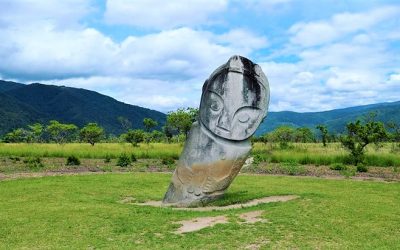Home / Batik Regions – Central Indonesia – Sulawesi Island – Central Sulawesi / Pusentasi – Donggala Sea Well
Natural Destination
Experience the tropical nature!
Pusentasi – Donggala Sea Well
Pusentasi – Donggala Sea Well
Pusentasi of Donggala sea well is one of natural phenomenon in Central Sulawesi. Pusentasi, literally means “the center of sea” in Kaili dialect. The water volume of this giant natural well depends on the tides that flow from Donggala Sea. The unique characteristic of this well is that the blue water remains clean at any condition, both during high and low tides. The locals believe that the water has great healing power.
Natural Tourism Destination
Pusentasi – Donggala Sea Well
Tourist Attractions in Central Sulawesi
Pulau Dua in Banggai
If you want to have an adventure getaway in nature paradise, Pulau Dua is one of a kind. It is situated in
Pamona Cave
Rumor has it, that this cave is the house of some dead bodies from Pamona Tribe. Apart from the
Lore Lindu National Park
Designated as part of the UNESCO World Network of Biosphere Reserves, Lore Lindu National Park is
Central Sulawesi
Batik Motifs
Bomba Mawar
This motif means sacred love for family, kingdom, and God; It also illustrates
Taiganja
Taiganja is a precious gold pendant that shows the social status of the Kaili family. It is
Cengkeh
The clove flower motif is the main commodity of the Tolitoli Regency. This motif represents
Sero Tangga
The Sero Tangga illustrates an endearing feeling and sacrifices of a person to fulfil
Discover
Indonesian
Batik
Motifs
Tikar Natuna
The Tikar Natuna motif is adapted from the traditional making of pandanus mats in
Ikan tambal
The word “Ikan” refers to fish. The philosophical meaning of Ikan Tambal means is
Tangerang Herang
Tangerang Herang motif is a symbol of Tangerang city. The Tangerang Herang batik motif consists of
Rangkiang
The word “Rangkiang” refers to the rice granary in the Minangkabau language. It symbolizes
Lontara
The Lontara script itself is a typical ancient script of Bugis and Makassar communities. History records that
Awan Berarak
Awan Berarak is a combination of Dayak motifs and Malay patterns. The word ‘Awan Berarak’ means the
Daun Sirih
This motif illustrates betel leaves that are used by Lombok communities as traditional
Pala Salawaku
This motif illustrates the unique weapons of the Maluku region, namely
Buketan Bali
The Balinese bouquet (Buketan Bali) is a floral arrangement and the name is
Taiganja
Taiganja is a precious gold pendant that shows the social status of the Kaili family. It is
Pati-Pati Pinehiku
It symbolizes the hierarchy in society and the social status of the Mekongga
Mahkota Siger
Siger is the crown of a noblewoman in ancient time. It is a symbol of femininity, strength, and
Lipaq Sabe
Lipaq Saqbe contains a simple geometric classical motif with various flower decorations. This textile is
Sandeq
Sandeq Boat is a symbol of the maritime importance of the West Sulawesi region. The greatness of
Prada Papua
The word “Prada” in the Javanese-Indonesian dialect means a batik textile that
Bultiya
The word ‘Bultiya’ is an acronym of the three major tribes in North Kalimantan, namely
Bale Lumbu
This motif signifies the welfare of the ancient Sasak society. Bale also symbolizes the
Durian Pecah
Broken Durian motifs depict the foundation of faith. The second half signifies the mastery of
Biji Kopi
The coffee seeds motif illustrates the pride of local coffee specialities in
Honai
The Honai is inspired by the traditional house of the Papuan community living in
Kuda Kupang
Horses symbolize wealth. It contains noble values of virtuous characters that bring
Insang Ikan
Insang refers to the gills of the fish. This is a typical pattern of Malay ethnic who inhabits
Daun Lada Hitam
The black pepper motif represents the main commodity of Bangka Belitung
Sido Mulyo
Sidomulyo is one of the classical motifs, which is specifically used for the bride’s costume in
Kaharingan
The Kaharingan or ‘tree of life’ based on the Dayak tribes’ belief system. This tree symbolizes
Parang Seling
Parang Seling or “alternating daggers” is a royal batik motif. It is a feminine variant of
Besurek Rafflesia
The term “Basurek” refers to a textile that contains letters or inscriptions
Gonggong Siput
Gonggong (Strombus Turturella) is one type of sea snail found around
Malinau Cultural Festival
You will witness a unique competition that might not be found other than in
Raja Ampat
Raja Ampat motif represents the marine life at Raja Ampat archipelago in
Tifa Totobuang
The batik motifs illustrate Maluku’s traditional music instrument called
Salakanagara
Salakanagara batik motif illustrates the first kingdom in the Betawi land
Sekomandi
Its philosophical meaning is the eternal union which refers to a saying “until death do us part”
Cengkeh
The clove flower motif is the main commodity of the Tolitoli Regency. This motif represents
Besurek Rembulan
This batik illustrates praise for God who created the wonderful universe
Kasih Tak Sampai
‘Kasih Tak Sampai’ is an idiom in the Indonesian language which refers to
Wakatobi
It symbolizes the coastal beauty of the Wakatobi island and the symbol of Patra symbolizes
Gonggong Beruntun
This motif illustrates that a person should maintain a positive attitude and
Kerawang Tegak Aceh
The Vertical Upright (Kerawang Tegak) Motif symbolizes a person who has a strong
Kawung
The Kawung motif was created by Sultan Agung Hanyokrokusumo (1593 – 1645) as a symbolic gift for
Karawo Pinang
Pinang refers to the Palm areca tree. This motif is considered as the original
Paqbarre Allo
The word “Barre” means round and “Allo” means the sunlight. This motif is interpreted as
Ukir Sentani
The Ukir motif is a batik motif that is inspired by various traditional Sentani wood carvings
Dayak Kamang
Kamang motif is generally found in the Dayak tribe shield because it is believed to
Teguh Bersatu
This batik motif shows the strength of the people of Kupang. It also represents a sense of
Tampuk Manggis Sasirangan
The motif illustrates the philosophy of the mangosteen fruit, which is
Lok Baintan Floating Market
As you can imagine, the most authentic thing is that you can buy things and even
Jupri Kembang Teh
Kembang Teh illustrates the tendrils of tea plants that grow in the highlands of
Angsa Duo
According to legend, the Angso duo batik motif is a pair of swans that are believed to have led Princess
Gedhog Kembang Waluh
a combination of Javanese cultural motif of the Majapahit kingdom (XII-XIV century) with
Hiu Taliyasan
Indonesia is also home to the world’s largest fish, the whale shark (Rhincodon typus). Hiu Taliyasan refers to
Sekar Jati
Sekar means flower and Jati refers to teak trees that symbolizes a strong mental character that
Merak Ngeram
The hatching peacock motif has a very deep meaning which refers to the sacrifice and
Gigi Haruan Lidi
The Gigi Haruan Lidi motif is taken from the name of the cork fish and is a symbol of
Pohon Hayat (Tree of Life)
The Batik motifs in Lampung are dominated by the acculturation of Buddhist and
Tengkawang Ampiek
With its many advantages, the Dayaks use this leaf in ritual ceremonies. This plant is a symbol of
Kain Cual
Cual textile tradition has existed since the 17th century. The word “Cual” refers to
Sero Tangga
The Sero Tangga illustrates an endearing feeling and sacrifices of a person to fulfil
Srimanganti
The name of the Srimanganti motif is derived from Palace’s hallway that connects to
Bomba Mawar
This motif means sacred love for family, kingdom, and God; It also illustrates
Burung Bidadari
Bidadari birds are endemic birds in Halmahera. This motif represents an
Bintik Tujuh
The Bintik Tujuh (Seven Dots) motif has 7 white spots and green color gradation as
Kaganga Tanah Rejang
If Batik Besurek combines Arabic calligraphy motifs, then the Kaganga batik takes
Parang Rusak
Another meaning behind this motif is an unconquerable spirit, symbolized by
Gumin Tambun
Based on Hindu mythology, this motif symbolizes lucks, abundant wealth, and
Dayak Taghol
Dayak Taghol has a distinctive style of four curved lines and small dots. This motif represents
Bekantan Pakis
This motif represents Pakis Haji (Polystichum setiferum), an endemic plant in
Karawo Mahkuta
Mahkuta refers to Gorontalo’s traditional crown. It represents noble characters of
Daun Simpor
This motif is inspired by the Simpor plant (Dillenia Suffruticosa) which is a typical
Gurdo Solo
Gurdo or garuda bird is the mount of the Indian god Vishnu. As the Sun Bird,
Desa Na Tolu
The Desa Na Tolu characteristic pattern symbolizes the Batak philosophy of existence and
Manguni Minahasa
Manguni is identified as the symbol of the Minahasa people. Manguni is known as a
Jumputan Bintang
The word Jumputan means the tie-dye technique, while the word “Bintang” refers to
Gentala Arasy
Built as high as 80 meters, the tower also highlights the historical side of
Pucuk Rebung Riau
Pucuk Rebung symbolizes heart determination in achieving goals, good luck, and
La Galigo
La Galigo is a literary work of the Buginese Epic that has 300 thousand epic lines. It is considered even




